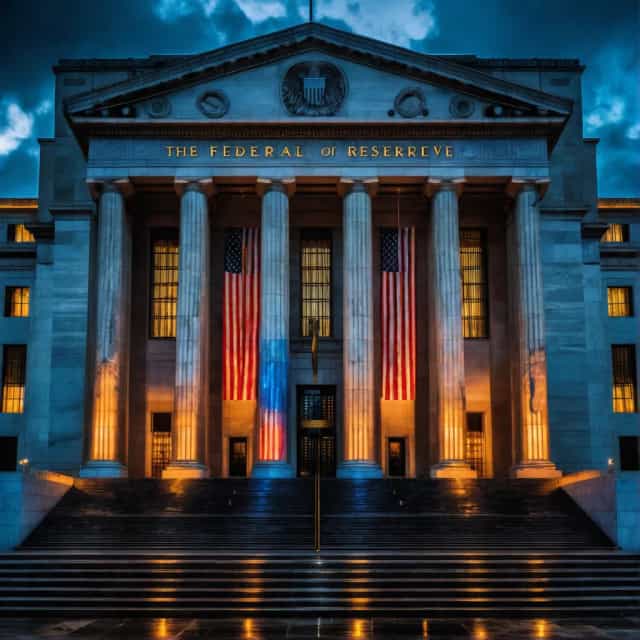
Image source: Block Media
Fed Reduces Interest Rates by 0.25% Amid Labor Market Slowdown, Signals Additional Cuts Likely
The Federal Reserve, under the leadership of Chairman Jerome Powell, implemented a 0.25% cut to its benchmark interest rate, citing signs of weakening in the labor market. While Powell confirmed the possibility of further rate reductions based on evolving economic conditions, the anticipated larger cut of 0.5% sought by some market stakeholders did not transpire. The decision sent shockwaves through financial markets, with both equities and commodities experiencing declines. Bitcoin (BTC) briefly slid below $11,500, while gold prices dropped over 1% following the announcement and Powell's subsequent statements.
First Rate Cut After Five Holds, More Expected in 2023
During the Federal Open Market Committee (FOMC) meeting on the 17th, the interest rate range was lowered from 4.25%-4.5% to 4.0%-4.25%. Notably, this marks the first rate reduction following five consecutive meetings where rates were held steady. The Federal Reserve also indicated the likelihood of two additional cuts before the year’s end.
Chairman Powell underscored the labor market’s softening pace during a press conference, stating, “The rate of job creation is insufficient to sustain existing levels of unemployment. It is no longer accurate to describe the labor market as exceptionally strong.”
This cautious tone reflects the Fed’s intent to mitigate the risks of economic stagnation while addressing imbalances in labor demand.
Political Pressures and Fed's Decision Dynamics
The Federal Reserve's decision comes amid intense political scrutiny, particularly from the White House. President Donald Trump has persistently pushed for more aggressive rate cuts, exerting influence by appointing loyal economic advisers to key Fed positions. Meanwhile, legal battles over board member appointments and potential removals have added further tension.
Among these controversies, Lisa Cook and newly appointed board member Steven Myron remain key figures. Notably, the FOMC’s vote on the rate cut was 11 to 1, with Steven Myron dissenting and advocating for the larger 0.5% reduction. Addressing inflation, Powell commented, “Our responsibility is to treat price increases stemming from tariffs as a temporary issue, while ensuring sustained economic stability.”
Fed's Cautious Stance Viewed as 'Risk Management'
The Federal Reserve maintains a measured perspective regarding monetary policy moving forward. Although inflation has seen modest increases and labor market risks are more pronounced, Powell emphasized that rate decisions would be evaluated on a meeting-by-meeting basis depending on economic data.
Market analysts predominantly interpret this latest rate cut as a "risk management" strategy designed to preemptively address potential economic slowdowns. U.S. Treasury yields reflected this sentiment, with the five-year yield climbing six basis points to reach 3.65%, signifying a decline in bond prices.
The Fed’s updated economic outlook includes projections of two more 0.25% cuts by year-end. Additionally, similar reductions are tentatively scheduled for 2026 and 2027. Modifications to the economic forecast also highlight increased expected growth in 2026 alongside a slight uptick in 2025’s inflation projections.
Labor Market Struggles, Inflation Risks Persist
Recent employment data revealed a rise in the national unemployment rate to 4.3% in August, marking the highest level in nearly four years. Simultaneously, inflation remains a significant challenge for the central bank, with its preferred inflation measure recording a 2.6% increase in July. Preliminary August data suggests further escalation.
The Fed remains divided on inflationary pressures. Some members see tariff-induced price increases as transitory, arguing for swift rate cuts to offset economic risks. Conversely, other officials caution against premature action, warning of potential long-term inflationary entrenchment.
During his August speech at the Jackson Hole Symposium, Powell addressed this growing divide, emphasizing the need to balance economic risks carefully. He acknowledged that future policy adjustments might be required to stabilize both employment and inflation, leaving financial markets speculating about forthcoming Federal Reserve actions.
By navigating these complexities with targeted rate cuts and data-driven assessments, the Federal Reserve aims to strike a delicate balance between fostering economic growth and controlling inflation. Markets and policymakers alike now anxiously await further developments, as the next steps in monetary policy remain vital to the trajectory of the broader U.S. economy.










